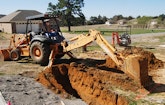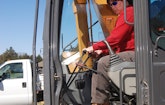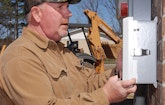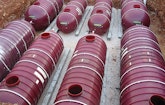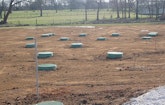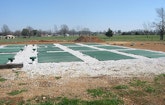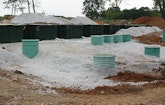Interested in Repair?
Get Repair articles, news and videos right in your inbox! Sign up now.
Repair + Get AlertsUnique system designs and construction techniques packaged with common onsite system components and unconventional financing plans keep Unique Backhoe Service busy in a down economy.
In the company's home territory around Vilonia, Ark., about 25 miles north of Little Rock, new home construction on isolated lots has nearly stopped, but owner Scott Nealey has barely noticed the slowdown. He has found creative ways to enable developments to build out. That also makes local governments happy, because it brings in new tax revenue.
His secret lies in building cluster treatment systems, using gravity or pressurized collection and conveyance for septic tank effluent, with aerobic treatment units that discharge to drainfields and directly to streams. New systems on virgin sites, including clusters, account for 80 percent of his business. The rest consists of replacements and management service.
A different path
After high school, Nealey worked for his dad's business installing waterlines. The business also included trenching for and installing utility services. All across the area, waterlines were being installed to new and existing houses as part of the bustling Rural Water program, and there was always more demand from builders who needed gas, electric or sewer hookups. Onsite systems, while not on the service menu, were never far out of sight.
"In 1998, one of my buddies went to Oregon to learn about Orenco Systems' advanced treatment units," says Nealey. "He came home all excited and told Dad and Mom about those systems. They visited the company, too, and they came home with a dealership."
About the same time, the Rural Water program was slowing down, and the opportunity was shifting to onsite system installations and emerging technologies. Being an Orenco dealer without customers to sell to provided no advantage, so Nealey started running ATU training sessions across the state to spread the word and generate sales.
"At first, only about two installers 'got it,'" he says. Some installers "got it" in a different way: "They would sell Orenco Systems jobs, then rely on me to actually do, rather than guide, their installations. That was working swell for the installers, but it doubled my workload. The installer got paid for the installation work but often didn't show up at the job site." In other words, Nealey did double the work for half the paycheck. As soon as he changed the way he did business, he could handle the distributor and mentor roles effectively.
A new focus
Being an Orenco distributor provided a thorough understanding of onsite systems, but eventually Nealey needed a change. He left the distribution enterprise and moved directly into onsite installation and clusters. Some might say he did it backwards, but he would disagree.
In cluster systems, individual homes are not served on a lot-by-lot basis. Groups of homes are handled using traditional onsite system components, some installed unconventionally. With Nealey's understanding of aerobic treatment, it is not surprising that each community system he has built incorporates that technology. "There is no practical limit on the number of homes that can be served by a cluster system," he says.
The basic components for an aerobic system serving 20, 40 or 150 homes are surprisingly similar to those for a single-family system. "We use the same skills and equipment we would on a single-family home job site, but our jobs are different because of their scale," Nealey says.
Central collection
Both single-family and community systems require treatment tanks. For Nealey's cluster systems, a septic tank is installed on the lot it will serve – if there are 50 homes, there are 50 septic tanks. A collector sewer receives effluent from each tank and conveys it to the treatment site. Depending on local conditions, flow may be by gravity or low-pressure pump.
"We prefer small-diameter pipes for this liquid-only collection system, but where gravity does not allow, we install small-diameter pressure collection," says Nealey. All of the effluent is delivered to a common site for aerobic treatment.
Most of his projects use clusters of treatment units. For example, an AdvanTex AX20 can handle the flow from a four-bedroom home but can't handle flows from multiple homes. Nealey's preferred solution is to use multiple AdvanTex AX100 units. "On one of our jobs, we clustered several units that together handle a flow of nearly 100,000 gpd," he says.
After the effluent passes through a treatment unit, it is ready for its ultimate disposition. Here, too, Nealey often has choices. Some systems don't use soil treatment, instead discharging fully treated effluent to a stream. If soil treatment is the best option, Nealey prefers drip systems. In either case, appropriate county or state level permitting is required.
Sequential installation
Very little of a system that serves 50 homes is installed at the beginning of a project. Components are installed in stages. "We prepare the entire plant site at the outset to minimize site disturbances once any portion of the system has gone online," Nealey explains. With the site ready, he can add treatment units to keep pace with development on the lots.
Collection system construction is also phased so that long stretches of unused pipe are avoided. "This means that there is little investment that is in place and unused; all of it can be considered as revenue-generating," Nealey says.
He applies the same principal to the absorption area, as well. A finished system that needs 100,000 linear feet of drip tubing to satisfy a state permit doesn't need all of it installed on the first day of operation. By dividing the system into four or more zones, he can defer expenditures and avoid finance charges. "Building and commissioning components only as they are needed saves everyone money," Nealey says. It's one reason local governments like his approach.
No cookie cutters
"We are in partnership with the city to finance, build and operate systems," Nealey says. "The partnership is formalized through a bid process, and each party's responsibilities are clearly defined. No two projects are alike. Even when the houses may look like a cookie cutter went through the neighborhood, the sewage treatment and financing arrangements are always project-specific and unique."
Unique Backhoe Service's first cluster project lived up to the company's name. The city, using its in-house labor pool and equipment, installed the collection system. Each homebuyer paid for the installation of a 1,500-gallon septic tank and effluent pump that discharged to the city's line. "At the far end of the collection system, we installed a cluster of AX100 units," Nealey recalls. "We also installed 48,000 linear feet of drip tubing divided across multiple zones."
Financing was secured in part through a 1-cent sales tax and state construction grants. "When a developer purchased a lot, in addition to the price of the land, a $5,000 capacity payment to the city was tacked on," says Nealey. "Even with land priced at $50,000 per acre, they couldn't build houses fast enough."
The homeowner pays a user fee to cover the routine operations and necessary system upgrades. Homeowners' tanks are also evaluated annually and, when appropriate, a pumper is called in to service them. For this
project, the city employed a licensed treatment plant operator.
Creative financing
On another development, Nealey installed the complete system from just outside the basement walls to the stream discharge point. "For this job, we were responsible for the electrical work at each house, as well as at the treatment cluster," he says.
At this site, the municipality did not qualify for grants, so the city found another creative mechanism for funding. "We installed the complete system," says Nealey. "The city leased the system to a different company, which operated it. Combining revenue from the 1-cent sales tax with user fees and up-front builder payments, the city was able to retire the system's construction debt in a year.
"It's important to understand how unique this project area is. Most of the properties served were occupied by existing commercial enterprises. It was the area's downtown. It was an area where a large number of wildcat repairs had been unsuccessfully attempted over the years." The generally unsuitable site conditions – small lots and consolidated sandstone bedrock at 24 to 30 inches below grade – exacerbated the problems and made a cluster the most viable solution.
The cost of the unused portions of the system must be financed from the revenue of the portion that is operating. Maximizing the city's customer base and the portion of the system that is in use, and generating revenue, benefits the city greatly. Nealey has pioneered the cluster system concept in his state and has played a major role in each of the five largest such systems.
Being small
Nealey mostly works solo, with a little help from family. "My mom, Deborah, is the most important part of my business," he says. "She takes care of me and the books." She, like his dad, Sonny, who helps with installations, are volunteers Scott is glad he can call on from time to time. Nealey's wife, Evon, fills in as needed, ferrying materials to job sites.
Nealey must be certain everything on each project is done right the first time. "Going back costs me a lot more than taking the time to do it right," he says. "There is no incremental cost to correctness; there is a major penalty for slipshod work."
Unique Backhoe's array of equipment is equally focused. It includes a Kubota KX 41-3 excavator, a Kubota L2800 tractor, a Case 580 Super M loader backhoe, a John Deere 450 J dozer, a Case 135 excavator with a 1,500-pound hammer, and a typical assortment of pickups and small support vehicles.
"Sometimes I find myself in a bidding war with other installers with whom I have good relations," Nealey says. Each bidder has a slightly different area of expertise or equipment roster, and usually the project at bid needs the skills of all the bidders – yet only one bid is awarded. "Regardless of the winner, we subcontract specialty work out to the best qualified among us," Nealey says. "This collaboration lets us all keep our overhead down and
lets us all share in the work. We all win – the project owner and all of the collaborators."
These competing companies have found themselves at work on about 90 percent of the large cluster systems in the state. Competition, collaboration and a willingness to change have been the common elements of Nealey's entrepreneurial life. He proves that small companies can succeed by seeing big-picture projects as big opportunities. O

